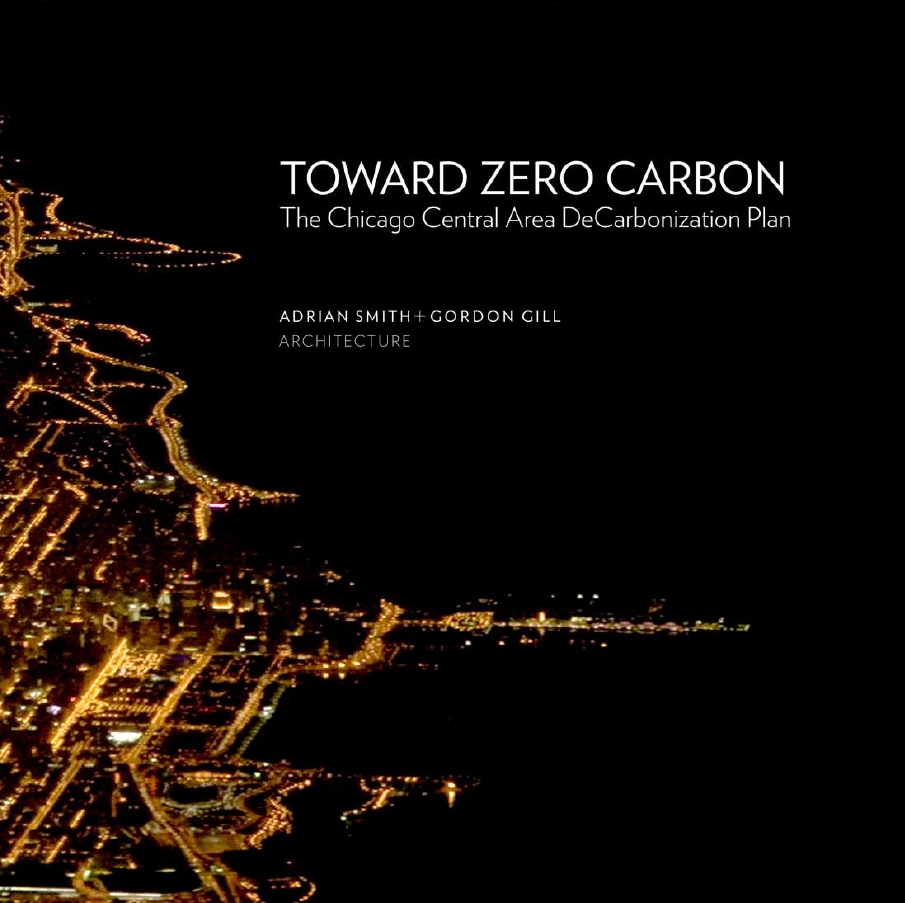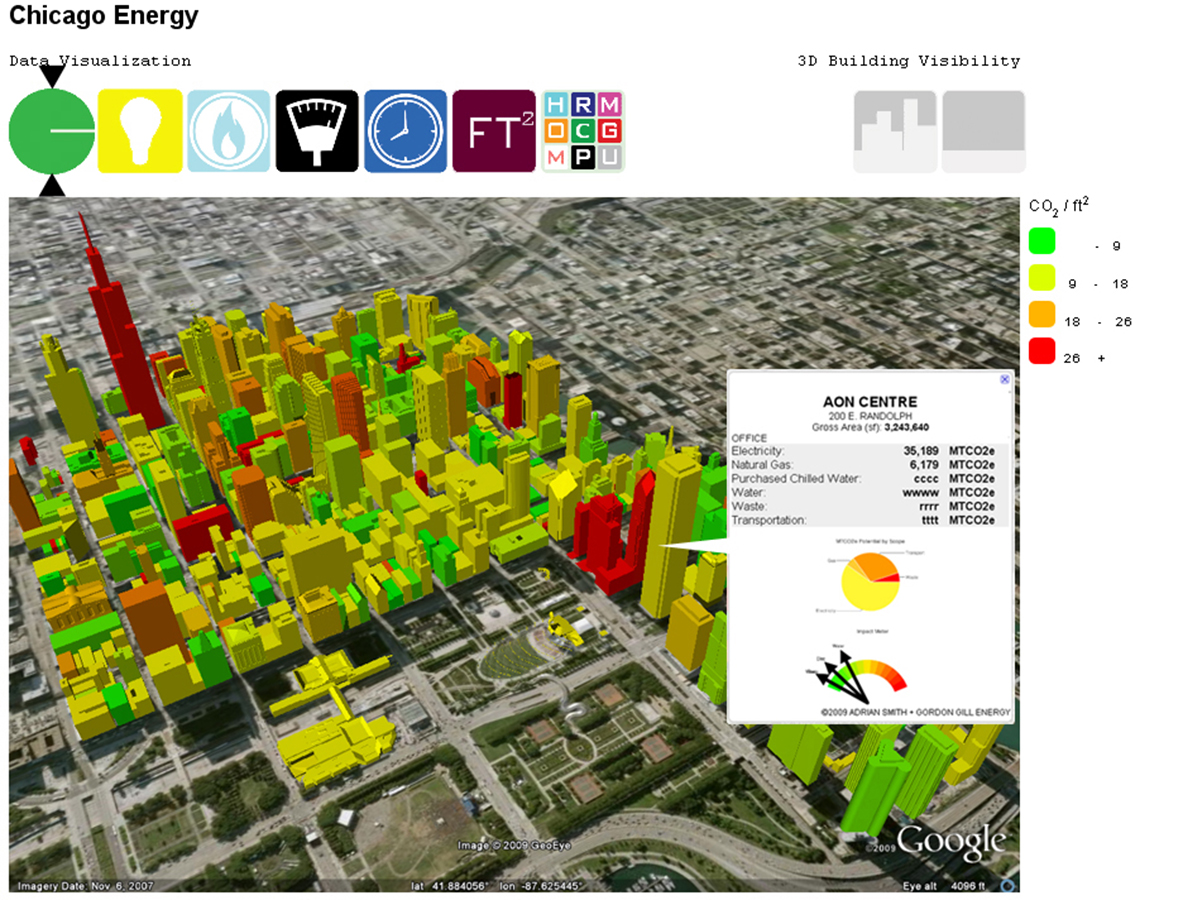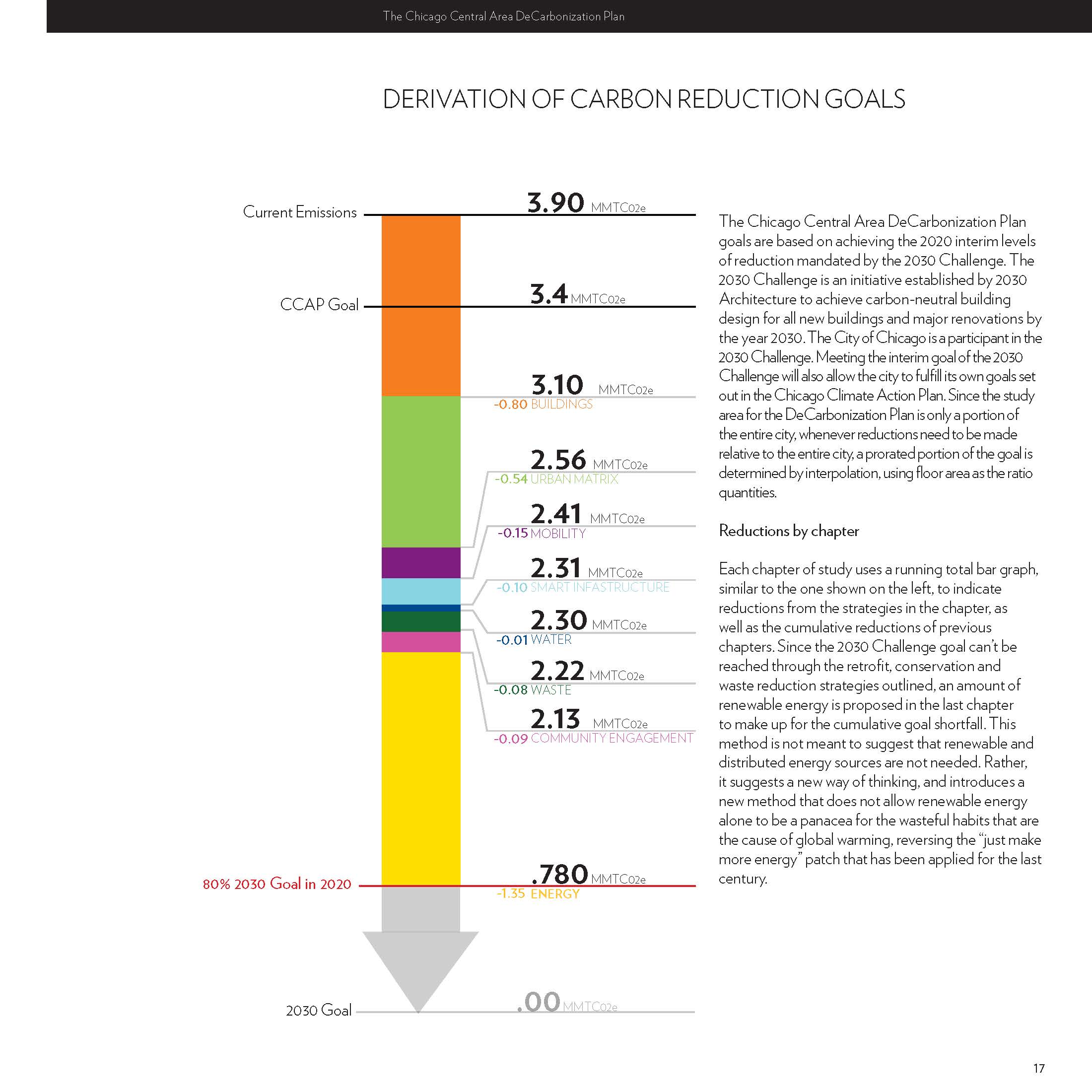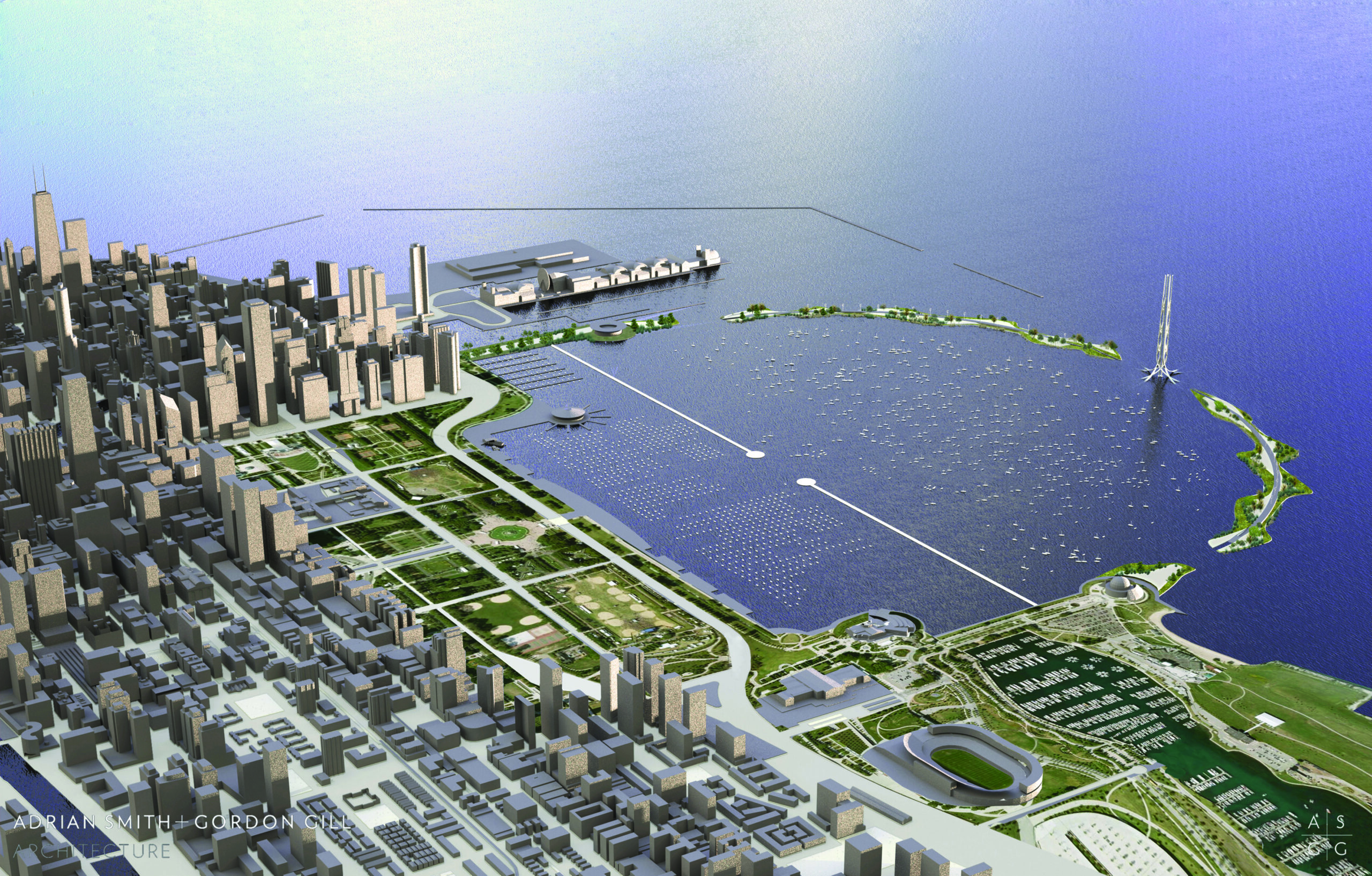TOWARDS ZERO CARBON
The Chicago Central Area Decarbonization Plan
Publication, Summer 2011

TOWARD ZERO CARBON: The Chicago Central Area Decarbonization Plan
Toward Zero Carbon presents Adrian Smith + Gordon Gill Architecture’s award-winning Chicago Central Area DeCarbonization Plan, a comprehensive vision for helping the city reach its carbon reduction goals in the famous downtown Loop. A holistic approach that integrates architecture, energy engineering and urban design, the DeCarbonization Plan provides a roadmap for meeting the goals of the Chicago Climate Action Plan, which aims for a 25% reduction in carbon emissions from 1990 levels by 2020, and the 2030 Challenge, which sets a goal of 100% reduction in carbon emissions for new and renovated buildings by 2030. The plan’s eight key strategies address buildings, the urban matrix, energy, smart infrastructure, mobility, water, waste and community engagement. And although designed for Chicago, the DeCarbonization Plan can be adapted to other cities—as well as corporate, university and medical campuses—making Toward Zero Carbon a case study of a sustainable future across the globe.
You will find
discussions here…
*
What if we could tap into Chicago’s latent potential by using the existing built environment as a carbon asset?
*
What if we could redefine energy as a commodity to be traded between buildings, blocks, cities?
*
What if we could transform Chicago’s Loop into a net carbon-positive district?
While the carbon emissions metric combines all aspects of the building’s use, the energy use intensity data set compares buildings only by their major energy expenditure—the direct use of electricity and natural gas in proportion to their gross floor area. This is a standard metric commonly used to assess building performance.
Carbon Accounting, Planning and Reform at and Urban Scale
A strong DeCarbonization Plan addresses more than energy use and carbon emissions; it also addresses the state of existing building stock. It creates an opportunity for a true paradigm shift in the way citizens engage with their cities. Creation of new parks and public spaces, improvements to both the existing infrastructure and the integration of new methods of transit, foundation of community action groups and the education of our younger citizens are all critical components of a strong DeCarbonization Plan.
Buildings
In the United States, buildings account for an average of 40 percent of carbon emissions. In Chicago, that number soars to 70 percent. This disparity is caused by the fact that our transportation footprint is relatively small. But as in many cities of similar age, many of Chicago’s buildings feature inefficient and outdated systems that cause high energy loads.
This chapter analyzes Chicago’s existing building carbon emissions and energy usage by considering the components that are responsible for the majority of loads and by looking closely at how the different building types in the Loop perform.
We outline procedures to transform the existing Chicago Loop building stock into a more efficient neighborhood comprised of buildings that enjoy symbiotic relationships and produce energy.
Urban Matrix
Commercial space in Chicago’s downtown Loop accounts for 90% of its land use and 97% of its carbon emissions. By contrast, the Loop contains almost no residential space and virtually none of the amenities and support infrastructure that many
homeowners value in their neighborhoods, such as schools, daycares, parks or grocery stores. This virtually forces those who work in the area to look elsewhere in the city for suitable housing and living environments. Analysis also confirms the lower
carbon footprint created by mixed-use, 24-7 high density communities.
This chapter examines a number of approaches to creating a vibrant urban core in the downtown area, including increased amenities and new schools. Design solutions include the conversion of select existing buildings into new residential buildings, the addition of new high-performance commercial towers, a new parkway along Monroe Street, a larger presence of green roofs, new pocket parks and a new Daley Environmental Learning School.
Mobility
To successfully entice more of the population to use sustainable modes of transit, the city needs to augment existing transit and incorporate new systems to accommodate commuter needs.
This chapter analyzes the relationship between urban density and gas consumption. Cities that have denser cores generally have lower per-capita gasoline consumption. A further analysis looks at rail and bus commuting, bicycle and pedestrian routes and the existing public service fleets, including taxis.
Logical, integrated solutions, as well as new trends, are explored. Design solutions are proposed to enhance the quality of life of Loop residents and commercial tenants.
Smart Infrastructure
Energy consumption in the United States (and, correspondingly, in the city of Chicago) has dramatically escalated over the past several decades, significantly outpacing population growth as new devices have become ubiquitous in our daily lives. While new technologies have led to increased strain on an aging infrastructure, they also present new opportunities to improve the intelligence and distribution efficiency of energy and information, engendering new infrastructure intelligence. This chapter examines regional trends in energy supply and distribution and focuses on low-carbon technologies. Strategies such as smart grids are expanded to encompass the broader scope of smart infrastructure, which goes beyond supply-and-demand management strategies and seeks to add city amenities through information technologies.
We consider four distinct networks: the real estate, public realm, transportation and utilities sectors. We identify specific Chicago projects, such as a clean energy taxi program and a vehicle-to-grid car-sharing network.
Water
It’s difficult for many Chicagoans to imagine that the high-quality water they enjoy might be a source of greenhouse gas emissions. To a degree, this mindset is understandable, given the proximity and relatively pure nature of our main water source. But in fact, the purification, delivery and heating of potable water, as well as the treatment of wastewater, can be significantly improved to reduce the overall carbon footprint of water in Chicago.
This chapter studies two broad areas to investigate methods for carbon reduction. Reducing the carbon load in a gallon of water is followed by a look at conservation efforts to create a cascading strategy for carbon reduction.
Design solutions present several possibilities for the carbon loading and conservation sides of the carbon reduction effort for water. Solutions range in scale from the replacement of aerators on sinks to the restoration of wetlands.
Waste
A large percentage of the municipal waste generated in Chicago can be recycled or reused. But to achieve the reduction goals of the future, the city needs to augment the existing waste infrastructure. In the spirit of conservation, Chicago can reuse existing systems, such as the coal tunnels, in new ways to efficiently collect and transport waste. Much of what can’t be recycled can be converted into clean new forms of energy, reducing carbon even further.
The analysis section identifies waste materials that the city should focus upon. Existing and new waste initiatives, as well as the use of an existing tunnel framework to collect and channel waste out of the city, will help meet Chicago’s current carbon goals.
Design solutions offer possibilities for reduce the carbon load of waste treatment, such as repurposing the city’s existing network of underground tunnels as a pneumatic waste removal system.
Community Engagement
Participation in community activities enhances shared feelings of citizenship and pride. The expansion of social networks from new technologies will strengthen and change both identification and interaction between fellow Chicagoans. While citizens can use these new social mediums to create larger communities dedicated to sustainability, they can also refocus their energy to develop action-oriented groups that provide incentives for more sustainable attitudes.
The strategies within this chapter examine concepts of branding, green team organizations, multilingual advertising and educational materials and social marketing programs. By promoting change, Chicagoans will become more aware of and ultimately involved in the carbon reduction initiative. A series of proposed initiatives, from urban agriculture to large-scale learning environments, will inspire and educate the community to incorporate these ideals into their everyday lives.
Energy
Rapid growth in energy demand in the United States is taxing an aging energy infrastructure, leading to brown-outs and lost economic output. Moreover, it has led to increased reliance on foreign energy sources, creating the potential for geopolitical tensions and consequential environmental damage.
In this chapter, regional trends in energy supply for the state of Illinois and Chicago are studied in aggregate and broken down by energy source (coal, natural gas, nuclear and hydroelectric). Trends are projected for 2020, taking into account pending federal legislation that would mandate reductions in aggregate carbon emission factors, suggesting an increased reliance on low-carbon technologies such as wind and photovoltaic energy. These systems are also compared based upon their capital intensity and annual carbon abatement costs.
We also examine strategies for on-site renewable and co-generation of energy, complemented by off-site renewable and district energy strategies. We propose three distinct scales of solutions that integrate elements of a new energy equation within Chicago’s built environment.
The Chicago Central Area Decarbonization Plan
AS+GG Carbonlab


